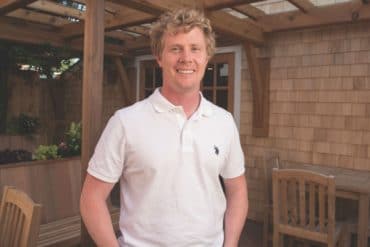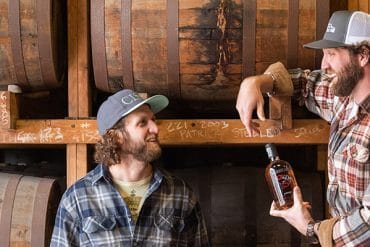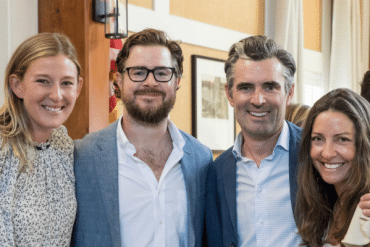 From his Benjamin Franklin haircut down to his Converse high tops, Gene Mahon is a Nantucket icon. Walk into most any social event, no matter the season or venue, and there he’ll be, camera in hand, document- ing the night for his weekly e-newsletter, “Mahon About Town.” Over his forty-four years on Nantucket, Mahon has owned and operated more businesses than he can recall. Past ventures include a record store, a copy center, a production house, a publishing house, a television station, a photography gallery, a camera shop and a legendary nightclub. Historically speaking, Gene Mahon is a relic of a forgotten era on Nantucket—the psychedelic sixties and seventies.
From his Benjamin Franklin haircut down to his Converse high tops, Gene Mahon is a Nantucket icon. Walk into most any social event, no matter the season or venue, and there he’ll be, camera in hand, document- ing the night for his weekly e-newsletter, “Mahon About Town.” Over his forty-four years on Nantucket, Mahon has owned and operated more businesses than he can recall. Past ventures include a record store, a copy center, a production house, a publishing house, a television station, a photography gallery, a camera shop and a legendary nightclub. Historically speaking, Gene Mahon is a relic of a forgotten era on Nantucket—the psychedelic sixties and seventies.
In the spring of 1969, fresh out of Villanova and after a year of adventures out West, Gene Mahon arrived on Nantucket as part of a wave of young hippies. With their long hair, ragged beards and bare feet, these so-called “flower children” were treated as pariahs. When they walked up Main Street, little old ladies cowered in fear and crossed to the other side. Tour buses slowed past jobsites where hippies worked as painters and carpenters and pointed them out like exotic wildlife. “These are some of the only hippies on Nantucket,” the driver would inform his passengers over the intercom. Some snapped photos. The stops became so frequent that pretty soon the workers just smiled and waved on cue. On the weekends, hippies and islanders played each other in basketball and volleyball, and the games often became physical enough to leave the hippies limping off the court with bruised ribs and bloody noses. Suspicion of the hippie minority ran so high in some cases that the bank declined their checks, or insurance companies refused to sign up their businesses. Yet even for a hippie, Nantucket was a place of boundless possibility, and few saw that possibility more than Gene Mahon.
Within his first five weeks on the island, Mahon was running his own painting crew. He then opened a photography gallery on Centre Street where he hung his black and white landscape prints and encouraged other photographers to show their work. At the time, there was only one camera shop on the island, and Mahon became its most loyal patron. One day he walked in and the shop owner Charlie Folger threw him the keys. “Forget it, I’m done,” he sighed. “Here, you run it.” And with that Folger walked out. As casually as if he owned the place himself, Mahon stepped behind the counter and began tending shop. Indeed, he would eventually buy the camera shop, thus confirming his place in Nantucket society.
And what a society it was. Come noon each day, the center of town became the center of the universe, with every walk of life descending upon it for lunch and perhaps a couple midday drinks. Many of the storefronts were old and splintered, a far cry from the gilded lilies that would sprout up in the years to come. The beloved watering hole of most hippies was the Bosun’s Locker, a dark, dingy bar on Main Street with all the character and characters of an old whaling saloon. On a rainy day, the barman might as well have charged rent, as men, women and children hunkered down for hours on end.
On the other end of the social spectrum was the Opera House, the headquarters of Nantucket’s high society, frequented by old money, artists and highbrow summer residents. European-style waiters floated about the room with upturned noses as a honky-tonk piano filled the restaurant with ragtime. Opera House owner Gwen Gaillard held court each night at table one. To sit at Gaillard’s table was to be accepted into Nantucket high society. Everyone wanted to sit with her. One night, she invited a hippie-turned-businessman to join her for dinner. Gene Mahon had officially arrived, and quickly became a notable fixture at the chic Opera House.
Mahon’s taste for the Nantucket nightlife led him to become part owner of the Roadhouse in 1978, what he today describes as the “hottest nightclub the island has ever known.” Owned along with writer and pianist Frank Conroy and local businessman Bill Torpey, Mahon’s Roadhouse was a Gatsbian revival, complete with flowing champagne and world-class jazz.The Roadhouse became the after-hours spot for famous actors, artists and the island’s who’s who pouring out of the Opera House each night. Dustin Hoffman drank there. So did American playwright Arthur Miller, and the owners of Studio 54. Jimmy Buffet often dropped in for impromptu performances. The stage saw the likes of jazz greats Buster Williams, Stan Strickland and Joe Lovano, now considered the greatest jazz horn player in the country. At the center of it all was Gene Mahon, less than a decade on Nantucket, exactly where he was meant to be.
More than thirty years later, Gene Mahon continues to be a barometer of our times and a link to times long gone. He has since sold the camera shop, closed the photo gallery and shut the doors to the Roadhouse. Other businesses have also come and gone over the years, leading Mahon to reinvent himself again and again. What remains unchanged is his passion for the island and his belief that the best is yet to come. “Nantucket has been very kind to me,” he says today. “Since coming ashore for the first time in 1969 and deciding within hours that I wanted to make this my home, I’ve done my best to make it a better place to live, joining the hundreds and hundreds of others who have made that same choice…We’ll make it a better place to live.” As for his hippie roots, let’s just say Gene Mahon is still pretty far-out.





